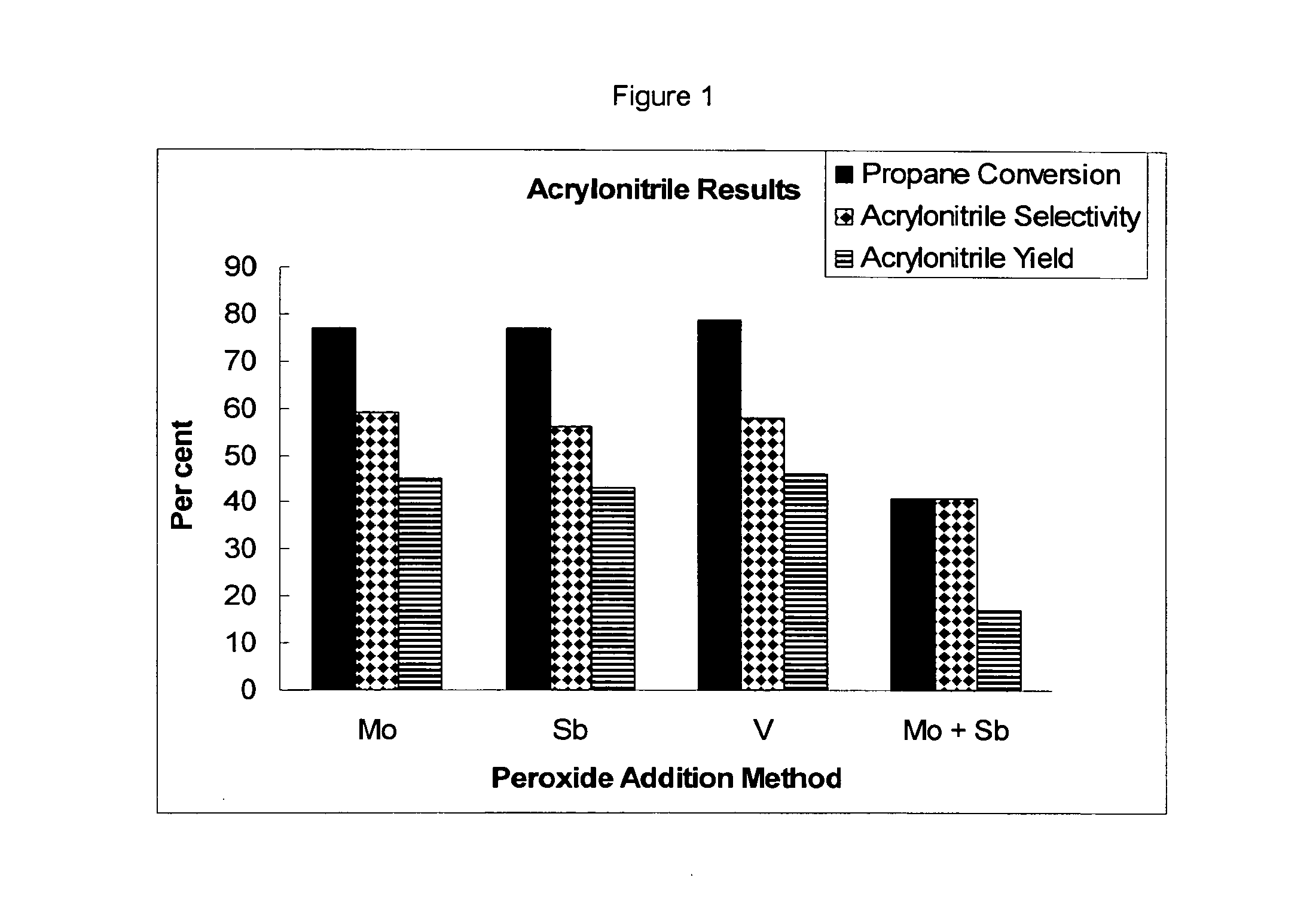Method of making mixed metal oxide catalysts for ammoxidation and/or oxidation of lower alkane hydrocarbons
a technology of ammoxidation and/or oxidation of lower alkane hydrocarbons, which is applied in the direction of metal/metal-oxide/metal-hydroxide catalysts, physical/chemical process catalysts, bulk chemical production, etc., can solve the problem that the catalysts made by the methods described above do not provide the selectivity and yield required for a commercial application
- Summary
- Abstract
- Description
- Claims
- Application Information
AI Technical Summary
Benefits of technology
Problems solved by technology
Method used
Image
Examples
example 1
Peroxide Plus Mo Method
Mo1.0 V0.25 Sb0.167 Nb0.08 Nd0.002 Ce0.003 Te0.04 Li0.013Ox
[0096]In a 5 gallon reaction container Reaction Solution A1 was prepared by (i) adding ammonium heptamolybdate (2343 g) to 7537 ml of deionized water, and then (ii) adding hydrogen peroxide (30 wt %, 360 g) was drop wise with stirring over 15 minutes.
[0097]Reaction Solution A2 was prepared in a manner identical to Reaction Mixture A1.
[0098]Reaction Mixture B was prepared in a 20 gallon reactor. First, 20159 g deionized water was added and heated to 90° C. Ammonium metavanadate (776 g) was then added with stirring while maintaining the temperature at 90° C. Next 619 g Sb2O3 was added. The resulting mixture was allowed to react with stirring at 90° C. for one hour to yield Reaction Mixture B.
[0099]Reaction solution C was prepared by dissolving 835 g ammonium niobium oxalate in 2170 g deionized water at 50° C. and then stirring the solution for 15 minutes at 50° C.
[0100]Reaction Solutions A1 and A2 were ...
example 2
Peroxide Plus Molybdenum Method
Mo1.0 V0.25 Sb0.167 Nb0.08 Nd0.002 Ce0.003 Li0.013 Ox
[0108]Reaction Mixture A was prepared by adding ammonium heptamolybdate (189.1 g) to 500 ml of deionized water and then adding hydrogen peroxide (30 wt %, 30.4 g) was drop wise with stirring over 15 minutes.
[0109]Reaction Mixture B was prepared by (i) adding ammonium metavanadate (31.3 g) to 400 cc water, (ii) heatingthe solution with stirring to 90° C., and then adding(iii) antimony oxide (Sb2O3, 26.1 g) and then (iv) allowing the mixture to react with stirring at 90° C. for one hour.
[0110]Reaction Mixture A was then added to Reaction Mixture B with stirring and the combined mixture was heated to 90° C. with stirring. The combined reaction mixture was then heated with stirring at 90° C. for an additional hour.
[0111]The combined reaction mixture was cooled to 70° C. Silica sol (Nalco, 369 g, 32.5% silica) was then added. The reaction mixture was then stirred at 70° C. for 30 minutes.
[0112]The combin...
example 3
Mo1.0 V0.25 Sb0.167 Nb0.056 Nd0.002 Ce0.003 Li0.013 Oz
[0116]Reaction Mixture A was prepared by adding ammonium heptamolybdate (189.0 g) and ammonium metavanadate (31.3 g) to 500 ml of deionized water.
[0117]Reaction Mixture B was prepared by adding antimony oxide (Sb2O3, 26.1 g) to 400 cc water.
[0118]Reaction Mixture A was heated with stirring to 90° C. and then maintained at that temperature for one hour. Towards the end of that hour, hydrogen peroxide (30 wt %, 30.4 g) was added with stirring to Reaction Mixture B. Two minutes after the addition of hydrogen peroxide Reaction Mixture A was added to Reaction Mixture B. The combined mixture was brought to 90° C. and then maintained at that temperature with stirring for three hours.
[0119]The combined reaction mixture was then cooled to 70° C. Silica sol (Nalco, 369 g, 32.5% silica) was then added. The reaction mixture was then stirred at 70° C. for 30 minutes.
[0120]The combined reaction mixture was cooled ...
PUM
| Property | Measurement | Unit |
|---|---|---|
| Temperature | aaaaa | aaaaa |
| Temperature | aaaaa | aaaaa |
| Temperature | aaaaa | aaaaa |
Abstract
Description
Claims
Application Information
 Login to View More
Login to View More - R&D
- Intellectual Property
- Life Sciences
- Materials
- Tech Scout
- Unparalleled Data Quality
- Higher Quality Content
- 60% Fewer Hallucinations
Browse by: Latest US Patents, China's latest patents, Technical Efficacy Thesaurus, Application Domain, Technology Topic, Popular Technical Reports.
© 2025 PatSnap. All rights reserved.Legal|Privacy policy|Modern Slavery Act Transparency Statement|Sitemap|About US| Contact US: help@patsnap.com

